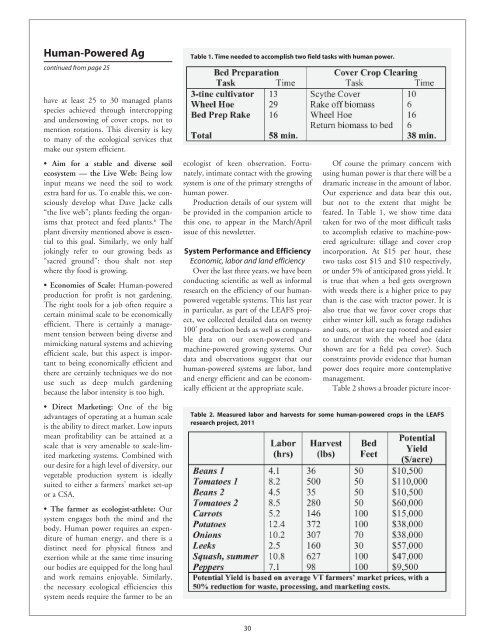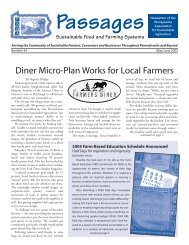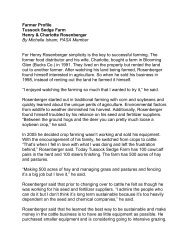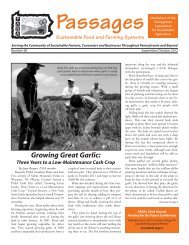Passages Sustainable Food and Farming Systems - PASA
Passages Sustainable Food and Farming Systems - PASA
Passages Sustainable Food and Farming Systems - PASA
Create successful ePaper yourself
Turn your PDF publications into a flip-book with our unique Google optimized e-Paper software.
Human-Powered Ag<br />
continued from page 25<br />
Table 1. Time needed to accomplish two field tasks with human power.<br />
have at least 25 to 30 managed plants<br />
species achieved through intercropping<br />
<strong>and</strong> undersowing of cover crops, not to<br />
mention rotations. This diversity is key<br />
to many of the ecological services that<br />
make our system efficient.<br />
• Aim for a stable <strong>and</strong> diverse soil<br />
ecosystem — the Live Web: Being low<br />
input means we need the soil to work<br />
extra hard for us. To enable this, we consciously<br />
develop what Dave Jacke calls<br />
“the live web”; plants feeding the organisms<br />
that protect <strong>and</strong> feed plants. 6 The<br />
plant diversity mentioned above is essential<br />
to this goal. Similarly, we only half<br />
jokingly refer to our growing beds as<br />
“sacred ground”: thou shalt not step<br />
where thy food is growing.<br />
• Economies of Scale: Human-powered<br />
production for profit is not gardening.<br />
The right tools for a job often require a<br />
certain minimal scale to be economically<br />
efficient. There is certainly a management<br />
tension between being diverse <strong>and</strong><br />
mimicking natural systems <strong>and</strong> achieving<br />
efficient scale, but this aspect is important<br />
to being economically efficient <strong>and</strong><br />
there are certainly techniques we do not<br />
use such as deep mulch gardening<br />
because the labor intensity is too high.<br />
• Direct Marketing: One of the big<br />
advantages of operating at a human scale<br />
is the ability to direct market. Low inputs<br />
mean profitability can be attained at a<br />
scale that is very amenable to scale-limited<br />
marketing systems. Combined with<br />
our desire for a high level of diversity, our<br />
vegetable production system is ideally<br />
suited to either a farmers’ market set-up<br />
or a CSA.<br />
• The farmer as ecologist-athlete: Our<br />
system engages both the mind <strong>and</strong> the<br />
body. Human power requires an expenditure<br />
of human energy, <strong>and</strong> there is a<br />
distinct need for physical fitness <strong>and</strong><br />
exertion while at the same time insuring<br />
our bodies are equipped for the long haul<br />
<strong>and</strong> work remains enjoyable. Similarly,<br />
the necessary ecological efficiencies this<br />
system needs require the farmer to be an<br />
ecologist of keen observation. Fortunately,<br />
intimate contact with the growing<br />
system is one of the primary strengths of<br />
human power.<br />
Production details of our system will<br />
be provided in the companion article to<br />
this one, to appear in the March/April<br />
issue of this newsletter.<br />
System Performance <strong>and</strong> Efficiency<br />
Economic, labor <strong>and</strong> l<strong>and</strong> efficiency<br />
Over the last three years, we have been<br />
conducting scientific as well as informal<br />
research on the efficiency of our humanpowered<br />
vegetable systems. This last year<br />
in particular, as part of the LEAFS project,<br />
we collected detailed data on twenty<br />
100’ production beds as well as comparable<br />
data on our oxen-powered <strong>and</strong><br />
machine-powered growing systems. Our<br />
data <strong>and</strong> observations suggest that our<br />
human-powered systems are labor, l<strong>and</strong><br />
<strong>and</strong> energy efficient <strong>and</strong> can be economically<br />
efficient at the appropriate scale.<br />
Of course the primary concern with<br />
using human power is that there will be a<br />
dramatic increase in the amount of labor.<br />
Our experience <strong>and</strong> data bear this out,<br />
but not to the extent that might be<br />
feared. In Table 1, we show time data<br />
taken for two of the most difficult tasks<br />
to accomplish relative to machine-powered<br />
agriculture: tillage <strong>and</strong> cover crop<br />
incorporation. At $15 per hour, these<br />
two tasks cost $15 <strong>and</strong> $10 respectively,<br />
or under 5% of anticipated gross yield. It<br />
is true that when a bed gets overgrown<br />
with weeds there is a higher price to pay<br />
than is the case with tractor power. It is<br />
also true that we favor cover crops that<br />
either winter kill, such as forage radishes<br />
<strong>and</strong> oats, or that are tap rooted <strong>and</strong> easier<br />
to undercut with the wheel hoe (data<br />
shown are for a field pea cover). Such<br />
constraints provide evidence that human<br />
power does require more contemplative<br />
management.<br />
Table 2 shows a broader picture incor-<br />
Table 2. Measured labor <strong>and</strong> harvests for some human-powered crops in the LEAFS<br />
research project, 2011<br />
30







